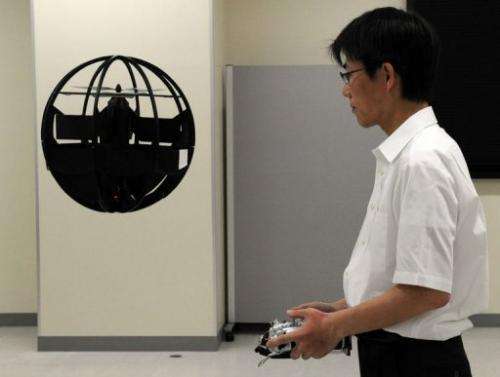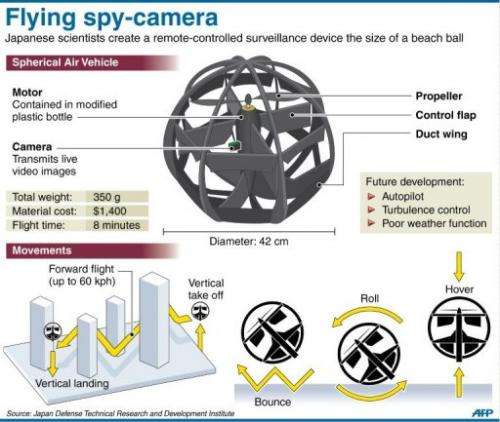Japanese inventor develops flying sphere drone

A Japanese defence researcher has invented a spherical observation drone that can fly down narrow alleys, hover on the spot, take off vertically and bounce along the ground.
About the size of a beachball and jet black, the remote-controlled Spherical Air Vehicle resembles a tiny Death Star from the Star Wars movies but has a more benign purpose -- to transmit live images from a video camera.
It is powered by a propeller protected by a spherical shield with large openings for airflow, meaning a knock into a wall or a tumble to the ground will not damage it.
Research to improve the device is continuing, but its designer says that in the future it could be used as a formidable pursuit vehicle that can travel above traffic or spy on a target through a window.
Its inventor in pacifist Japan hopes it could also help with non-aggressive operations, such as search and rescue in disaster zones, where it could fly through buildings and even up and down stairways.
"This is the world's first spherical air vehicle," said its developer, Fumiyuki Sato, a research engineer at the Defence Ministry's Technical Research and Development Institute in Tokyo.

The latest model, the seventh prototype, is equipped with a single propeller, shielded by the shell, with flaps and wings to control its flight, and can zip through the air at up to 60 kilometres (37 miles) per hour.
Sato said all its components can be found in shops in Tokyo's electronic tech-geek heaven of Akihabara, at 100-yen shops where every item sells for about a dollar, or on the Internet.
The motor at the core is contained by a modified plastic bottle, and the total cost for the parts come to 110,000 yen ($1,400) for the latest model, which weighs just 350 grams (12.3 ounces) and has a diameter of 42 centimetres (16.8 inches).
Sato admits that many hurdles remain before the flying sphere can be put to practical use, including adding an autopilot function and finding ways to cope with turbulence and poor weather conditions.
The current model could not, for example, be used at the stricken Fukushima nuclear plant, crippled by the March 11 quake and tsunami, because it can only fly within the field of vision of the controller, he said.
"Even though I can see footage from the mounted camera, it would be very difficult to control this" using the video, Sato said, noting that the drone floats in the air at a very delicate balance and cannot stop quickly.
Nonetheless, Sato sees a range of possible missions for the drone in future.
A more advanced model, he said, could hover above a motorcade for security, or, if in pursuit of a fleeing target, "it could go below an electric cable, fly above the next one, and then turn a street corner."
(c) 2011 AFP




















